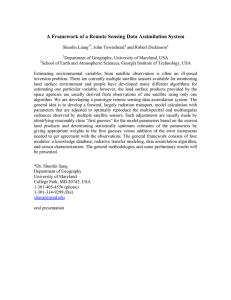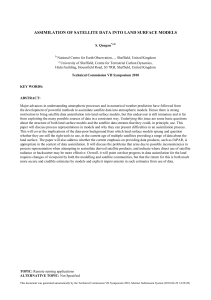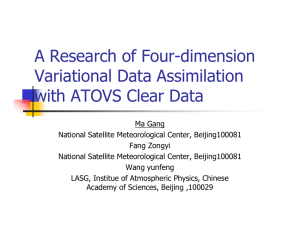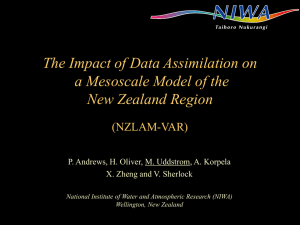Current use of satellite data in the Met Office Global... model
advertisement
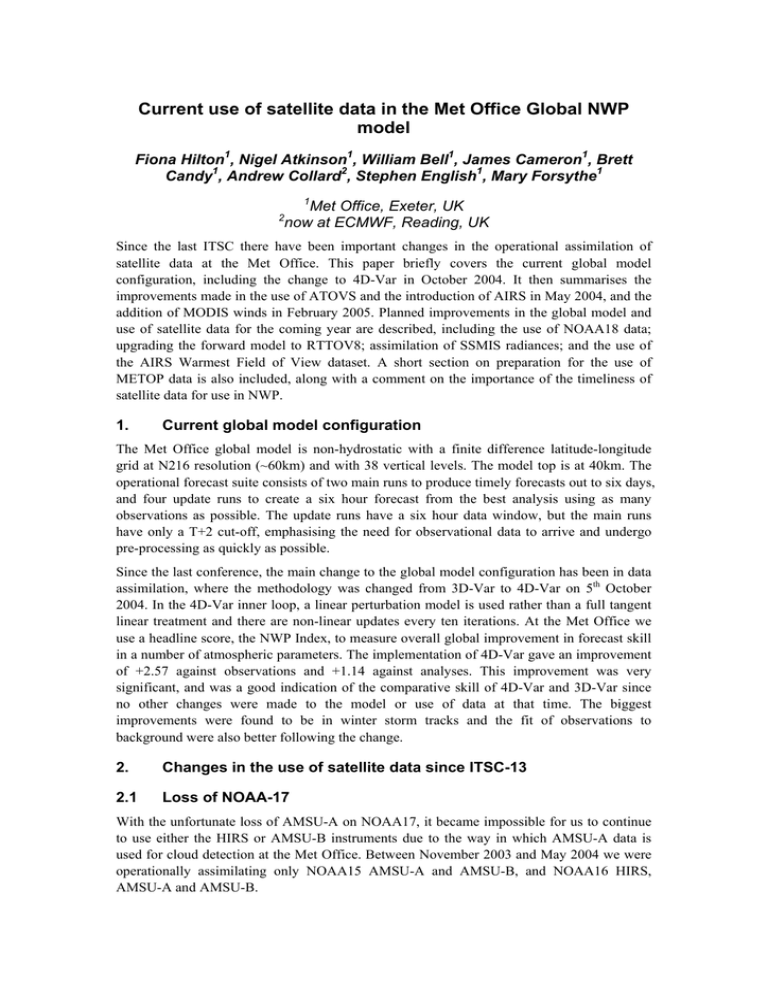
Current use of satellite data in the Met Office Global NWP model Fiona Hilton1, Nigel Atkinson1, William Bell1, James Cameron1, Brett Candy1, Andrew Collard2, Stephen English1, Mary Forsythe1 1 2 Met Office, Exeter, UK now at ECMWF, Reading, UK Since the last ITSC there have been important changes in the operational assimilation of satellite data at the Met Office. This paper briefly covers the current global model configuration, including the change to 4D-Var in October 2004. It then summarises the improvements made in the use of ATOVS and the introduction of AIRS in May 2004, and the addition of MODIS winds in February 2005. Planned improvements in the global model and use of satellite data for the coming year are described, including the use of NOAA18 data; upgrading the forward model to RTTOV8; assimilation of SSMIS radiances; and the use of the AIRS Warmest Field of View dataset. A short section on preparation for the use of METOP data is also included, along with a comment on the importance of the timeliness of satellite data for use in NWP. 1. Current global model configuration The Met Office global model is non-hydrostatic with a finite difference latitude-longitude grid at N216 resolution (~60km) and with 38 vertical levels. The model top is at 40km. The operational forecast suite consists of two main runs to produce timely forecasts out to six days, and four update runs to create a six hour forecast from the best analysis using as many observations as possible. The update runs have a six hour data window, but the main runs have only a T+2 cut-off, emphasising the need for observational data to arrive and undergo pre-processing as quickly as possible. Since the last conference, the main change to the global model configuration has been in data assimilation, where the methodology was changed from 3D-Var to 4D-Var on 5th October 2004. In the 4D-Var inner loop, a linear perturbation model is used rather than a full tangent linear treatment and there are non-linear updates every ten iterations. At the Met Office we use a headline score, the NWP Index, to measure overall global improvement in forecast skill in a number of atmospheric parameters. The implementation of 4D-Var gave an improvement of +2.57 against observations and +1.14 against analyses. This improvement was very significant, and was a good indication of the comparative skill of 4D-Var and 3D-Var since no other changes were made to the model or use of data at that time. The biggest improvements were found to be in winter storm tracks and the fit of observations to background were also better following the change. 2. Changes in the use of satellite data since ITSC-13 2.1 Loss of NOAA-17 With the unfortunate loss of AMSU-A on NOAA17, it became impossible for us to continue to use either the HIRS or AMSU-B instruments due to the way in which AMSU-A data is used for cloud detection at the Met Office. Between November 2003 and May 2004 we were operationally assimilating only NOAA15 AMSU-A and AMSU-B, and NOAA16 HIRS, AMSU-A and AMSU-B. 2.2 Satellite data assimilation upgrade in May 2004 In May 2004 there was a major upgrade to the use of satellite radiances in the Global NWP system. This upgrade was a package of several components most of which have been previously described: • Assimilation of AIRS data (Collard et al., 2003); • Assimilation of EOS Aqua AMSU data (to partially counteract NOAA17); • Increase in ATOVS data volumes over high land following introduction of modelbased predictors for bias correction (English et al., 2003); • Upgrade of radiative transfer code from RTTOV5 to RTTOV7 (Saunders et al., 2002); • Use of EARS ATOVS data (see Figure 1); • HIRS no longer assimilated. the loss of Figure 1: Left: Global ATOVS data only; Right: Global + EARS data. The blue points represent NOAA16 observations and the red points NOAA15 observations included in assimilation. With EARS there is more data meeting the cut-off. The loss of HIRS was not a desired change: the operational ATOVS assimilation code was not able to distinguish between locally received data (including EARS) and global data. Since we are unable to use locally received HIRS data, owing to problems with the calibration, it was unfortunately necessary to stop assimilating the global data as well. The increase in AMSU data through inclusion of EARS (Figure1) was found to have positive benefit despite the loss of the HIRS channels. Whilst data-denial experiments at the Met Office have shown little impact of HIRS data assimilated in the presence of AMSU, it is beneficial to assimilate HIRS to mitigate against the loss of AMSU channels. The reintroduction of HIRS is a planned change for the coming year (see Section 3). The expected impact of these changes on the basis of individual component tests was around +2.2 increase in NWP Index. In terms of this headline score, the complete package performed even better than expected (see Figure 2). Improvements of up to 9% in RMS error were seen in all tropospheric southern hemisphere fields, as well as increased skill in upper level tropical winds and northern hemisphere PMSL and 500hPa height fields. Additional improvement was seen in the forecasting of tropical cyclones following the introduction of the satellite package. During a trial period, it was found that positioning was 10% better, the intensity was improved, and cyclones developed more rapidly well before TC bogus observations are added. The first cyclone following the change was very well forecast. Combined with the evidence of improved tropical cyclone forecasting at ECMWF after the introduction of AIRS, it is likely that AIRS played an important part in these improvements at the Met Office also. 2 3 .5 1.5 3 2 .5 1 2 0.5 1 .5 0 1 v observations 0 .5 + A q u a A M S U -A + EA RS + A IR S + h ig h la n d RTTO V 7 -0.5 0 W eek 1 W eek 2 W eek 3 W eek 4 W eek 5 W eek 6 Post Op v Observations Figure 2: Improvement in NWP Index score for May 2004 satellite assimilation upgrade. Individual components were inserted one by one (left hand plot). Note that the actual numbers associated with individual components are unrealistic because various updates to bias correction were required throughout this period. The full package was then run for six weeks, during which time the NWP Index increased to an overall average of just under +2.5. 2.3 Introduction of MODIS winds, February 2005 MODIS polar winds from Aqua and Terra have been assimilated in the MetOffice global model since February 2005. Impact experiments showed the strongest improvements were to the temperature, height and wind fields at high to mid latitudes at mid levels (850-250 hPa) and at longer forecast range (T+72 onwards). One limitation to the usage of the MODIS winds is their timeliness. The current delay between observation time and receipt time is 3.5-7 hours. 3. Planned improvements in the coming year 3.1 Model and processing system changes By the end of 2005, it is planned that the global model will have enhanced resolution in both the vertical and the horizontal. Trials are underway of a 50 level model with a 66km top. It is also intended to increase the horizontal resolution to approximately 40km. In the meantime, a project is underway to improve the background error covariances in 4D-Var, which is expected to give a significant positive impact in verification against analyses. The initial implementation of 4D-Var did not include any modifications to the way data is selected in time and space for assimilation. It is expected that better selection of observations, in particular satellite observations which have dense coverage, so that they are more evenly spaced throughout the assimilation time steps, will result in forecast improvement. It is anticipated that during the next six months we will also upgrade the forward model from RTTOV7 to RTTOV8 (Saunders et al., 2005) for ATOVS processing. This will be a necessary step in the assimilation of stratospheric channels in the new 50 level model, as it has been found that the 43 pressure levels used for the radiative transfer calculations in RTTOV7 do not offer sufficient resolution in the stratosphere. The use of RTTOV8 is also an important change allowing further progress in the use of observations in scattering atmospheres and will also be necessary for forward modelling of IASI data in the future. It is anticipated that AIRS processing will still use RTTOV7. 3.2 Changes in the usage of satellite data In the next twelve months, we plan to make several changes to our use of polar-orbiting satellite data. With the successful launch of NOAA18, preparations are already underway for the assimilation of both global and locally-received AMSU-A and MHS data. Assuming that monitoring of the data passing passively through our assimilation system does not highlight any problems, it is intended to replace the use of EOS Aqua AMSU with NOAA18. We also intend to switch back on the use of HIRS channels where possible within the next year. Following delays to the receipt of real-time data and work in collaboration with the SSMIS Cal/Val team to understand instrument characteristics and biases, pre-operational trialling of the assimilation of SSMIS radiances is planned for Autumn 2005. The radiances require some pre-processing and quality control before being passed through the 1D- and 4D-Var systems. Current efforts are focussed on developing the pre-processing system. The Day One assimilation scheme will use clear and cloud affected radiances, with 1D-Var cloud profile retrievals used as input to the forward model in 4D-Var. Changes are also planned in the use of AIRS data following upgrades to the NEC supercomputer which allow an increase in data volume. Switching to the warmest field of view dataset from the central field of view should increase the yield of clear observations. In addition, we will be processing one FOV in nine instead of one in eighteen. The channel selection for AIRS will also be revisited, in the longer term introducing the use of data over land. 4. Preparations for METOP Preparations are underway for the use of data from the first METOP satellite, to be launched in April 2006. For initial implementation, we intend to use two data streams for the processing of the METOP sounding instruments. ATOVS will be processed via a HIRS-1d stream and there will be a separate IASI-1d format. The main difference between IASI and the satellite data currently in operational use at the Met Office is in data volume. It will not be possible to store all channels for all fields of view in our observations database, so use of IASI data will initially focus on the use of a subset of channels. However, it would be desirable to store the observations in principal component form and so we will consider the use of reconstructed radiances (Goldberg et al., 2003) if enough is understood about their error characteristics before we begin operational assimilation. In addition to this spectral data reduction, we also intend to thin the observations, probably to one footprint in four, by selection of the least cloudy FOV and through gross quality control checks. The FOV selection may simply rely on the choice of the warmest field of view, but it is planned to have more sophisticated cloud detection in place as well, for example employing the AVHRR statistical information available with each IASI footprint. The initial implementation of IASI data will be conservative, as with our use of AIRS data, initially focusing on clear FOVs over sea only. In the future we will begin to work on using data over land; using cloudy data; and possibly processing principal components rather than radiances, once radiative transfer for principal components is fully available and tested. 5. A comment on the requirement for timely data As mentioned in Section 1, the main forecast runs of the Met Office NWP system have a data cut-off of T+2. It is crucially important for the optimal use of observations that the data should arrive in good time. To illustrate this, Figure 3 shows the forecast impact on model fields which form the bulk of the NWP Index scoring, of including all ATOVS observations which have an observation time falling inside the assimilation time window. This is an increase over the number of observations assimilated operationally, as not all near-real time observations arrive in time to meet the cut-off. Over the period of this forecast impact study (3 weeks), decreases in RMS error of greater than 1% are above noise. It is clear that if we were able to include all ATOVS observations operationally, forecast improvements would be possible, particularly in the Southern Hemisphere. Similarly, as described in Section 2.3, further impact from MODIS winds would be possible if observations could be included in the main forecast runs. 1 0 -1 -2 -3 -4 -5 Obs summer SJ1 SZ3 SZ2 SZ1 SP3 SP2 SP1 TJ1 TU3 TU2 TU1 NJ1 NZ3 NZ2 NZ1 NP3 NP2 -7 NP1 -6 Analysis summer Figure 3: Percentage reduction in RMS forecast error obtained with using all possible ATOVS observations rather than only those which meet the data cut-off. Results are for a three week trial period. N denotes Northern Hemisphere, T Tropics, and S Southern Hemisphere. P is PMSL, Z Height, U 850hPa wind, J 250HPa wind. 1 is T+24 forecast, 2 T+48, 3 T+72. 6. Conclusions The following table represents the changes in the use of data from infrared and passive microwave instruments since ITSC-13. ITSC-13 ATOVS NOAA-15 AMSU (4-10,18,20) NOAA-16 HIRS (4-8,10-12,15), AMSU (4-8,10,18-20) ITSC-14 NOAA-15 AMSU (4-10,18,20) NOAA-16 AMSU (4-8,10, 18-20) NOAA-17 HIRS (4-8,10-12,15), AMSU (4-6, 8-10,18-20) EOS Aqua AMSU-A (4-6,8-10) SSM/I F13 and F15 windspeed AIRS MODIS winds F13 and F15 windspeed EOS Aqua 60/45 night/day channels; clear sea only EOS Aqua and EOS Terra Planned changes in the following year include introducing NOAA-18 data, reintroducing HIRS, using data from SSMIS and switching to AIRS Warmest Field of View. In the longer term, we are preparing for METOP data and intend to add AIRS data over land. 7. References Collard, A., Saunders, R., Cameron, J., Harris, B., Takeuchi, Y., Horrocks, L., 2003. Assimilation of data from AIRS for improved numerical weather prediction. In: Proceedings of the Thirteenth International TOVS Study Conference; Sainte Adèle, Canada, 29 October – 4 November 2003; ed. Saunders, R. and Achtor, T; http://cimss.ssec.wisc.edu/itwg/itsc/itsc13/proceedings/session2/2_4_collard.pdf English, S., Hilton, F., Candy, B., Whyte, K., Atkinson, N., Smith, A., Bell, W., O’Keeffe, U., Doherty, A., 2003. Operational use of ATOVS at the Met Office. In: Proceedings of the Thirteenth International TOVS Study Conference; Sainte Adèle, Canada, 29 October – 4 November 2003; ed. Saunders, R. and Achtor, T; http://cimss.ssec.wisc.edu/itwg/itsc/itsc13/proceedings/session1/1_2_english.pdf Goldberg, M.D., Qu, Y., McMillin, L.M., Wolf, W., Zhou, L., and Divakarla, M., 2003. AIRS Near-Real-Time Products and Algorithms in Support of Operational Numerical Weather Prediction, IEEE Transactions on Geoscience and Remote Sensing, v.41, p.379-389 Saunders, R.W., Matricardi, M., Brunel, P., English, S.J. and Deblonde, G., 2002. RTTOV-7: a satellite radiance simulator for the new millennium. In: The Technical Proceedings of the Thirteenth International TOVS Study Conference; Lorne, Australia, 28th February – 5th March 2002; ed. Le Marshall, J.F. and Apostolou, A.; http://cimss.ssec.wisc.edu/itwg/itsc/itsc12/rws_lorne.pdf Saunders, R., English, S.J., Francis, P., Rayer, P., Brunel, P., Kelly, G., Bauer, P., and Salmond, D., 2005. RTTOV-8 – the latest update to the RTTOV model. In: Proceedings of the Fourteenth International TOVS Study Conference; Beijing, China, 25th – 31st May 2005; ed .Saunders, R. and Achtor, T. Annex 1: The Met Office NWP Index In order to provide an objective global assessment of data assimilation or model changes the Met Office uses a basket of forecast verification scores. Each score is weighted against its perceived importance to create a global index. Whilst this index is not sufficient to judge any change it can be a useful objective way to compare a number of changes without subjectively selecting a particular verification score which favours one change above another. The index has risen by 25% over 10 years so the importance of new changes can be judged against past performance. The Index is compiled from mean sea-level pressure (PMSL), 500 hPa height (H500), 850 hPa wind (W850) and 250 hPa wind (W250). It is verified over the following areas: Northern Hemisphere 20N-90N (NH), Tropics 20N-20S (TR) and Southern Hemisphere 20S-90S (SH) and at forecast ranges from T+24 to T+120. Once the forecast and persistence root mean square errors have been determined for a particular combination of parameter/area/forecast range the skill score is calculated. This is defined in terms of reduction of variance, i.e. S = 1 – rf2/rp2 Where rf is the RMS forecast error and rp is the RMS persistence error. The weight given to each verification field is shown in Table 1. Table A.1: weights given to each forecast parameter in Met Office global NWP index. T+24 NH TR SH PMSL H500 W250 W850 W250 PMSL H500 W250 10 6 12 5 6 5 3 6 T+48 8 4 Forecast period T+72 T+96 6 4 2 3 2 4 2 3 1 2 T+120 4 2
